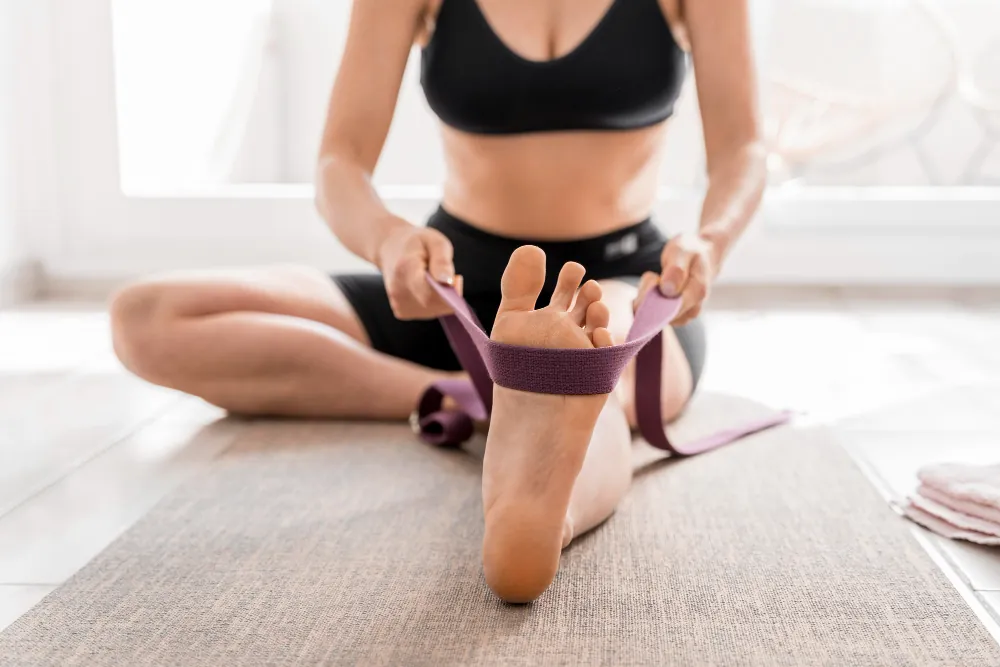Ankle injuries are brutal. One minute you’re walking, running, or training like normal, and the next, you’re limping around, wondering if you’ll ever feel stable again. And here’s the thing: ignoring recovery isn’t an option if you actually want to get back to doing what you love. You don’t have to wait forever or just hope your ankle magically heals itself. Ankle resistance band exercises are one of the smartest, fastest ways to rebuild strength, restore mobility, and actually speed up your comeback.
How Soon Can You Start with Ankle Resistance Band Exercises?
Don’t start with these exercises immediately, and definitely not while your ankle still looks like a balloon.
Here’s the timeline you could follow, but it’s always best to consult with your healthcare provider:
- First 48-72 Hours (Acute Phase): Forget about exercising. Your job is to rest, ice, compress, and elevate (R.I.C.E.). You want to control swelling and protect the joint, not stress it further. Any resistance band work right now is asking for trouble.
- 3-7 Days (Early Recovery): Once the swelling starts going down and you can move your ankle a little without sharp pain, you can begin with gentle, no-resistance movements. Something like ankle circles or tracing the alphabet with your toes. It’s about waking the joint back up, not building strength yet.
- After 7-14 Days (Mid Recovery): If swelling is mostly gone and you can bear some weight without major pain, now you’re ready. This is when light resistance band exercises can come into play. You’ll start re-training strength, stability, and flexibility, but keep it slow, controlled, and low-intensity.
- Beyond 3-4 Weeks (Late Recovery): This is where you can crank things up a notch. Once your ankle feels stronger and you’re moving comfortably, you can increase the resistance and add more complex movements like balance drills and weight-bearing exercises.
Best Ankle Resistance Band Exercises
When it’s time to get moving again, these are the ankle resistance band exercises you actually want to focus on. They hit all the major movement patterns your ankle needs to recover strength, control, and stability.
1. Dorsiflexion (Pulling Foot Up)
This movement strengthens the muscles on the front of your ankle, which are key for walking, running, and overall stability.
- How to do it:
-
- Sit on the floor with your leg straight.
- Loop a resistance band around the top of your foot.
- Anchor the other end (find something stable or have a partner hold it).
- Pull your toes back toward your shin, stretching the band.
- Return slowly.
- Keep movements controlled. No snapping.
2. Plantar Flexion (Pushing Foot Down)
With this exercise, you can strengthen the calf and improve push-off power for activities like walking and sprinting.
- How to do it:
-
- Same setup as dorsiflexion, but now you push your toes down, like pressing on a gas pedal.
- Slowly return to the start position.
- Don’t rush the return. Control both the push and release.
3. Inversion (Turning Foot Inward)
By doing this kind of movement, you can strengthen the inside stabilizer muscles that help prevent common sprains.
- How to do it:
-
- Loop the band around the inside of your foot.
- Anchor the band to the outside.
Pull your foot inward against the band’s resistance. - Focus on moving from the ankle, not the hip or knee.
4. Eversion (Turning Foot Outward)
This movement builds strength in the outer ankle muscles, protecting against rolled ankles.
- How to do it:
-
- Loop the band around the outside of your foot.
- Anchor it on the inside.
- Pull your foot outward.
- Small, controlled movements win here. You don’t need giant swings to see effects.
5. Ankle Circles with Resistance
This exercise trains the full range of motion and improves joint health.
- How to do it:
-
- Lightly tension the band across your foot.
- Move your ankle in slow, controlled circles (both clockwise and counterclockwise).
- Imagine you’re stirring a thick pot of soup with your toes… Slow and steady.
Can You Do These Exercises Proactively?
Absolutely. And honestly, you should.
You don’t have to wait for an injury to start strengthening your ankles. In fact, if you train them proactively, you’ll probably avoid injuries altogether.
If you’re an athlete, a runner, someone who hikes, or even just someone who occasionally steps awkwardly off a curb, strong ankles are non-negotiable. Resistance band exercises help build the small stabilizer muscles that normal workouts usually miss.
Final Thoughts
Your ankles take a beating every day. Whether you’re chasing goals or just chasing your dog. If you want faster recovery after an injury (or better protection against the next one), resistance band exercises aren’t optional, they’re essential.







